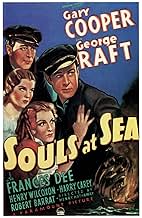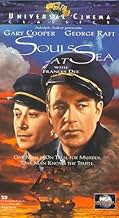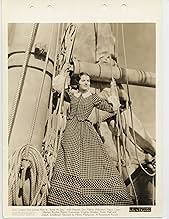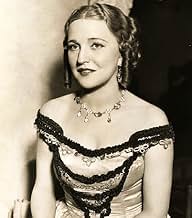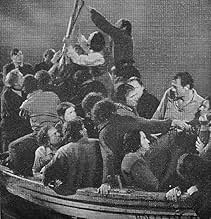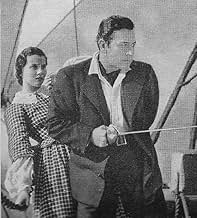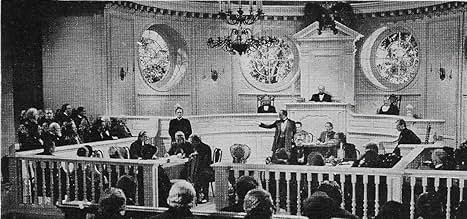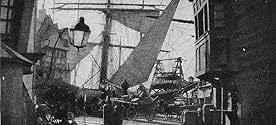IMDb-BEWERTUNG
6,8/10
947
IHRE BEWERTUNG
Füge eine Handlung in deiner Sprache hinzuCooper and Raft save lives during a sea tragedy in this story about slave trade on the high seas in 1842.Cooper and Raft save lives during a sea tragedy in this story about slave trade on the high seas in 1842.Cooper and Raft save lives during a sea tragedy in this story about slave trade on the high seas in 1842.
- Regie
- Drehbuch
- Hauptbesetzung
- Für 3 Oscars nominiert
- 3 Gewinne & 3 Nominierungen insgesamt
Norman Ainsley
- Ticket Taker
- (Nicht genannt)
Empfohlene Bewertungen
Everything is excellent here. Gary Cooper makes one of his great character roles of double depths, George Raft makes for once a great contribution, all the characters are natural and organic, the realism is magnificent, the glory of the era of the sailing ships is enhanced and lifted out of the screen, and even the music is perfect, with many glorious moments of innovation and good humour, and the quality of the drama, both human and natural, is undeniable in its realisation with a formidable shipwreck to crown the masterpiece. Henry Hathaway knew his business thoroughly, he never committed mistakes, and this is just one of his many masterpieces.
I never really found Gary Cooper to be the most invigorating of actors, but he delivers well here in this tale of maritime treachery. We start at a trial where he ("Nuggin") is being indicted for the killing of survivors from a seaborne disaster in the mid 1800s. It's while the evidence is being given that we are taken back on a retrospective of just how this honourable seaman found himself caught up, with his friend "Powdah" (George Raft) in the evil machinations of "Tarryton" (Henry Wilcoxon). When the boat he was travelling on manages to hit an iceberg, he is left to take charge. As usual there aren't enough spaces on the life boats so panic ensues, and a fairly "survival of the fittest" one at that, the results of which result in his current predicament. How to prove his innocence? Well that might lie in the hands of "Woodley" (George Zucco) who is working for the British Government on a mission to finally eradicate slavery, and who knows a thing or two about the real character of "Nuggin". It's a tautly directed adventure for the first half with plenty of duplicity going on, but when his relationship with "Margaret" (Frances Dee) starts to take a more prominent role in the story, we head into a rather disappointing form of 1930s soapdom. Raft tries his best and in many ways reminded me of Robert Newton but his loyal and decent character is sadly underused whilst the more interesting and perilous anti-slavery storyline becomes a little too subsumed amidst the lace and umbrellas. It's still a film that's well paced for the most part and one that makes you realise that the abolition of slavery in itself didn't actually halt this odious practice in the United States. There were still plenty of officials complicit in this lucrative activity.
I was hoping for a melodrama instead, but the emphasis here is on the narrative rather than on action. But I am pleased to report that my headline is accurate, because "Souls At Sea" is a very interesting story about a subject barely touched upon in Hollywood's long, colorful history. Reading through other reviewers takes on the film, it qualifies more accurately as a semi-historical drama, although not the first story Hollywood has taken liberties with. The temptation is to call "Souls At Sea" a 'seafaring yarn', but, as I said, it is heavy on talk and light on second unit work.
In any case, this offbeat movie has Gary Cooper faced with a moral dilemma as an abolitionist involved in the slave trade in the middle of the 19th century. His sidekick is George Raft, in as sympathetic a role as he ever had and one of his best acting jobs (never one of his strong points). Frances Dee is an ingenue on board the ship in question, and George Zucco plays a good guy for a change. Particularly effective is the background music which won an AA nomination for composer Milan Roder. Henry Wilcoxon is an effective bad guy and Olympe Bradna, whose film appearances were too few, is touching as a maidservant and love interest for George Raft.
Very well done, as is the norm with a Henry Hathaway picture. The story is so absorbing that the viewer nearly forgets about the lack of action scenes, and is well worth my rating of seven.
In any case, this offbeat movie has Gary Cooper faced with a moral dilemma as an abolitionist involved in the slave trade in the middle of the 19th century. His sidekick is George Raft, in as sympathetic a role as he ever had and one of his best acting jobs (never one of his strong points). Frances Dee is an ingenue on board the ship in question, and George Zucco plays a good guy for a change. Particularly effective is the background music which won an AA nomination for composer Milan Roder. Henry Wilcoxon is an effective bad guy and Olympe Bradna, whose film appearances were too few, is touching as a maidservant and love interest for George Raft.
Very well done, as is the norm with a Henry Hathaway picture. The story is so absorbing that the viewer nearly forgets about the lack of action scenes, and is well worth my rating of seven.
Here is a film that inexplicably has been given little exposure to modern audiences. Paramount threw in a lot of its top talent to tell a good story with drama, humor and lots of action.
Nuggin Taylor (Cooper) has waged a one-man war against slaves ships in the 1840s. His best friend Powdah (Raft) has been a slaver, if a half-hearted one, for years. The two board a packet from Liverpool to America in a plot to undermine the slave shipping lines, but also on board is their main nemesis and his sister. Naturally Taylor has a "thing" for the sister. When a tragic accident befalls the ship, Taylor must take drastic action to save passengers and is ultimately charged with multiple murders.
Cooper again plays the aw-shucks persona he perfected but here combines it with the literate, committed character of Nuggin. Note that in the lengthy opening sequence he says nothing, but is the center point of every word. Raft, who was always at his best for Henry Hathaway, gets crimped hair and an earring and the package works for the uneducated, footloose Powdah, who is ironically terrified of water. Raft's trademark unblinking stare is used to great effect and even humor. Copper and Raft, who sing together so pleasantly here, remained good friends after making this film.
The picture took three photographers. Estimable Charles Lang split the cinematography duties with Merritt Gerstad. Gordon Jennings was in charge of the special photographic effects in the climactic ship disaster. Their decisions were mostly excellent. Especially effective were the constant tilted angles aboard ship. The black-and-white filming offers up rich tones and texture, instantly setting the stage with the slave cargo sequence. The action scenes are outstandingly photographed and executed.
In period pieces, Hollywood tends to go overboard with layers of decorations. In 'Souls at Sea' art directors Hans Dreier and Roland Anderson are magnificently restrained and very accurate. That and A.E. Freudeman's interior decoration make the film seem really in Philadelphia, really in Liverpool and really on board a ship in 1842.
This is a great example of Hathaway's work, weaving appropriate humor into the human drama and relationships. There is an amusing montage as Taylor is scouring Liverpool for Powdah, and that relationship's integrity is maintained throughout.
This is a classic well worth making the effort to find.
Nuggin Taylor (Cooper) has waged a one-man war against slaves ships in the 1840s. His best friend Powdah (Raft) has been a slaver, if a half-hearted one, for years. The two board a packet from Liverpool to America in a plot to undermine the slave shipping lines, but also on board is their main nemesis and his sister. Naturally Taylor has a "thing" for the sister. When a tragic accident befalls the ship, Taylor must take drastic action to save passengers and is ultimately charged with multiple murders.
Cooper again plays the aw-shucks persona he perfected but here combines it with the literate, committed character of Nuggin. Note that in the lengthy opening sequence he says nothing, but is the center point of every word. Raft, who was always at his best for Henry Hathaway, gets crimped hair and an earring and the package works for the uneducated, footloose Powdah, who is ironically terrified of water. Raft's trademark unblinking stare is used to great effect and even humor. Copper and Raft, who sing together so pleasantly here, remained good friends after making this film.
The picture took three photographers. Estimable Charles Lang split the cinematography duties with Merritt Gerstad. Gordon Jennings was in charge of the special photographic effects in the climactic ship disaster. Their decisions were mostly excellent. Especially effective were the constant tilted angles aboard ship. The black-and-white filming offers up rich tones and texture, instantly setting the stage with the slave cargo sequence. The action scenes are outstandingly photographed and executed.
In period pieces, Hollywood tends to go overboard with layers of decorations. In 'Souls at Sea' art directors Hans Dreier and Roland Anderson are magnificently restrained and very accurate. That and A.E. Freudeman's interior decoration make the film seem really in Philadelphia, really in Liverpool and really on board a ship in 1842.
This is a great example of Hathaway's work, weaving appropriate humor into the human drama and relationships. There is an amusing montage as Taylor is scouring Liverpool for Powdah, and that relationship's integrity is maintained throughout.
This is a classic well worth making the effort to find.
Some of the events in "Souls at Sea" were inspired by a shipwreck in about 1840. However, despite appearances, it's clearly a highly fictionalized version of history and really doesn't claim to be a true story.
When the story begins, Nuggin (Gary Cooper) and Powdah* (George Raft) are serving aboard a slave ship. Although slavery was still legal in the States, it was illegal to import slaves...and the British navy enforced a blackade of slavers. If they caught them, the men serving aboard the slave ships were prosecuted...so you'd assume that the two men are evil. But you cannot have a film with slavers being the heroes...even back in 1937. Well, it turns out that Nuggin is actually working on his own as an anti-slaver....and he's had a history of scuttling these ships and setting the poor slaves free. As a result, he is made an undercover operative for the British...and his task involves getting to America as soon as possible to set a trap for other slave ships. But Nuggin's arch nemesis (Henry Wilcoxon) is also bound for the States to stop him...and they're aboard the same ship! What's next? Well, a lot!!
Apart from an interesting plot, the film benefits from good acting and some amazing shipwreck scenes....truly spectacular. Overall, a wonderful adventure film that isn't perfect (Raft seemed mostly wasted and in the way during most of the film), but is nevertheless well worth seeing.
* Who thought of these insane names?! Huh!??!
When the story begins, Nuggin (Gary Cooper) and Powdah* (George Raft) are serving aboard a slave ship. Although slavery was still legal in the States, it was illegal to import slaves...and the British navy enforced a blackade of slavers. If they caught them, the men serving aboard the slave ships were prosecuted...so you'd assume that the two men are evil. But you cannot have a film with slavers being the heroes...even back in 1937. Well, it turns out that Nuggin is actually working on his own as an anti-slaver....and he's had a history of scuttling these ships and setting the poor slaves free. As a result, he is made an undercover operative for the British...and his task involves getting to America as soon as possible to set a trap for other slave ships. But Nuggin's arch nemesis (Henry Wilcoxon) is also bound for the States to stop him...and they're aboard the same ship! What's next? Well, a lot!!
Apart from an interesting plot, the film benefits from good acting and some amazing shipwreck scenes....truly spectacular. Overall, a wonderful adventure film that isn't perfect (Raft seemed mostly wasted and in the way during most of the film), but is nevertheless well worth seeing.
* Who thought of these insane names?! Huh!??!
Wusstest du schon
- WissenswertesWhen Nuggin and Powdah are in a tavern, the bartender immerses a hot iron into their beer mugs. This was most likely part of making a popular sailor's drink at the time called a "flip". It was made with beer, rum, sugar or molasses (and possibly a spice like cinnamon or cloves). The hot poker caramelizes the sugar. The technique was also just a quick way to warm beer during the winter.
- PatzerReading Hamlet aloud, Gary Cooper says, "the thousand natural shocks that the flesh is heir to." The second "the" is a mistake--it spoils the scansion.
- Zitate
Michael 'Nuggin' Taylor: The floor of the ocean is paved with the bones of slaves.
- VerbindungenReferenced in Kein Platz für Eltern (1937)
- SoundtracksSusie Sapple
(1937) (uncredited)
Music by Ralph Rainger
Lyrics by Leo Robin
Performed by George Raft and Gary Cooper
Top-Auswahl
Melde dich zum Bewerten an und greife auf die Watchlist für personalisierte Empfehlungen zu.
- How long is Souls at Sea?Powered by Alexa
Details
- Laufzeit
- 1 Std. 32 Min.(92 min)
- Farbe
- Seitenverhältnis
- 1.37 : 1
Zu dieser Seite beitragen
Bearbeitung vorschlagen oder fehlenden Inhalt hinzufügen

